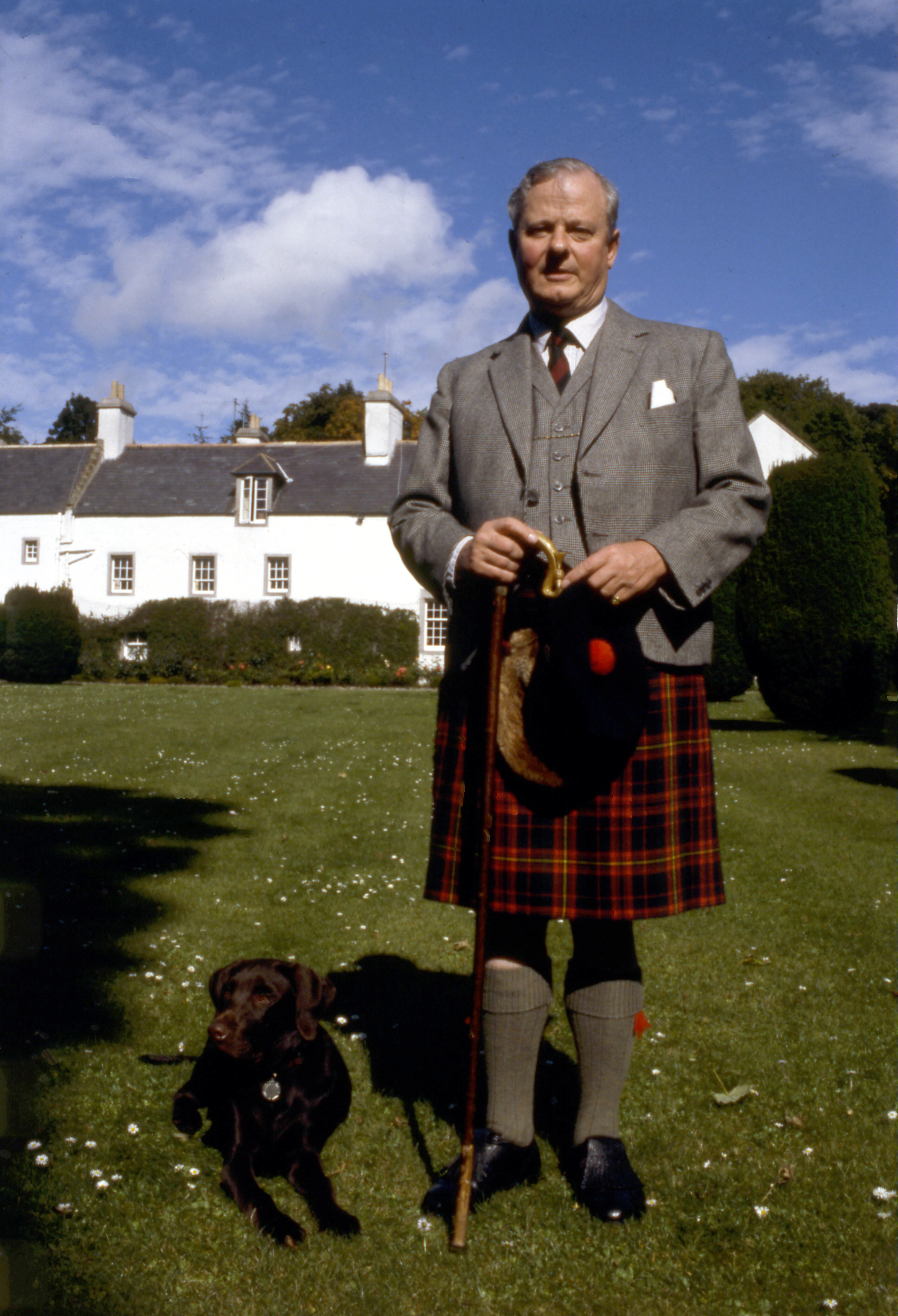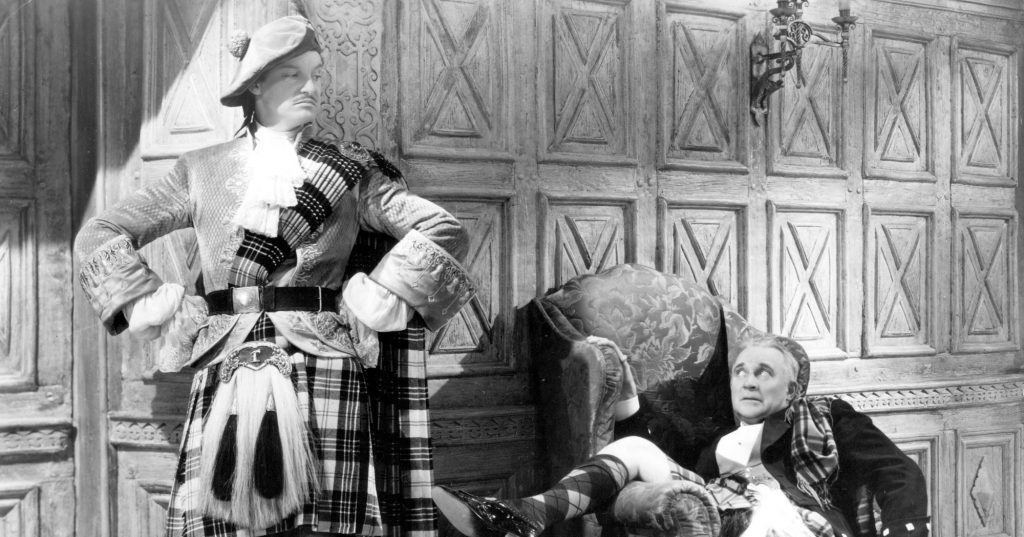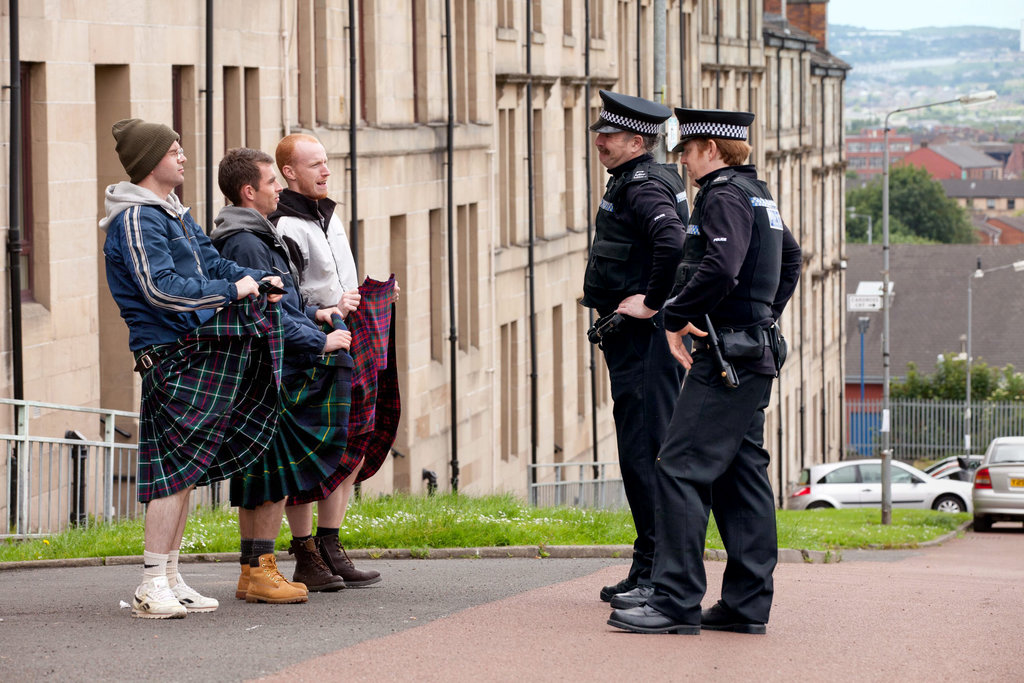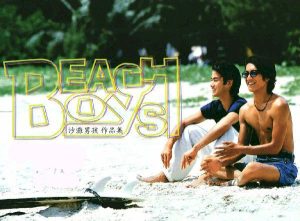The Imagined “Scotland” In Film
In preparation for the production of the film Brigadoon (Vincente Minnelli, 1954), producer Arthur Freed was shown possible filming locations around Scotland by Forsyth Hardy, Scottish film critic and co-founder of the Edinburgh Film Festival. After taking in the scenery “Arthur Freed went back to Hollywood and declared: ‘I went to Scotland but I could find nothing that looked like Scotland’” (Hardy 1990, p. 1). His reaction to and rejection of Scottish scenery for his film clearly shows there are pre-conceived notions of imagined Scottish-ness which have been shaped by popular literature and amplified by cinema. Brigadoon was eventually filmed on MGM sound stages in California. It is a musical telling the story of a Scottish village that appears for only one day once every 100 years, and may be the most famously inauthentic representation of Scotland in film. Clearly, Freed was not seeking to reproduce Scotland itself, but rather reproduce his quaint, romantic idea of an old-fashioned magical Scottish village. But why did Freed have a pre-conceived notion of Scotland, and how is it perpetuated?
If I asked you to picture Scotland in your head right now, you may well imagine this:

If I asked you to think of a Scottish person, you might think of this:

Or maybe even this!:

Why do these sorts of image come to mind? Are they an accurate representation of Scotland and Scottish-ness?
The nation of Scotland and its people has been reproduced on screen throughout cinema’s history, by numerous producers in a variety of ways. I hope to explore the ways in which images of Scotland and Scottish people are constantly reproduced, from silent cinema up to the present, so we can see the near impossibility of an undisputedly realistic representation of Scots, whether attempted by Hollywood, British filmmakers, or indigenous Scots themselves.
Tartanry
Contributing to Scotch Reels, a 1982 collection of essays critiquing various aspects of the Scottish film industry, Cairns Craig highlights one of the most widespread types of stereotyping used to represent Scotland in film: Tartanry. Tartanry is an emphasis on the old-fashioned, kilts and tartan, noble warriors and wild untamed lands, a Romantic Scotland untouched by modern civilization, as if from an antiquated and bygone age (Craig 1982). This romanticised ideal of Scotland, popularized and spread largely through the 19th century literature of Walter Scott, Robert Louis Stevenson, J.M. Barrie and others, existed even before cinema did. This is probably the most common flavour of stereotyping you will see regarding Scotland on screen, just think of Brave (Mark Andrews & Brenda Chapman, 2012)and Braveheart (Mel Gibson, 1995). You won’t have to look very far to find a wild landscape or noble, savage, warrior men and women.
The Execution of Mary Queen of Scots (https://movingimage.nls.uk/film/4413) is thought to be the earliest surviving representation of Scotland on screen, made in 1895 and produced in the United States by Thomas Edison’s production company. Men in kilts, many holding spears, stand around a chopping block as a woman kneels and is ‘beheaded’ with a very early example of special effects camera trickery. Right from the very beginning of film, Scotland’s representation is characterised by the popular literature that came before, imbued with tartanry.
Given the popularity of the likes of Scott and Stevenson’s works at the time cinema was in its infancy it’s no surprise that they significantly influenced the depiction of Scotland and Scottish-ness on screen in the early parts of the 20th century. This manner of representation was not unique to Scotland at this time, with cinematic reproductions of England and the U.S.A. in the early 20th century also tinged with the fantastical and romantic, a time in which the cinema was an “imagined land in which received images are played out as masquerade” (Caughie 2018, p. 149).
The advent of cinema also brought with it the ‘scenic film’, short films designed to show scenery of various places throughout the world. Many scenic films of Scotland were made in the 1910s and 1920s, with titles ranging from the romantic A Tour Through the Land of Burns (1922) to the slightly more matter-of-fact Scottish Scenery (1914). These were films that were “drawn to locations that are already imbued with romance and imagination and are memorialized in an earlier travel literature.” (Caughie 2018 p. 157). It’s worth noting that among the long (but not exhaustive) list of scenic films provided by Caughie (2018, p. 151), are all focused on nature, the historical, or the traditional, with no scenic films exploring any of Scotland’s contemporary cities of the time. This is easily explained by the scenic films being shown at cinemas all over the world, so the focus would be on the spectacular and unique rather than the every-day and contemporary to ensure interest, but it does contribute nonetheless to the narrowly focused reproduction of Scotland on screen in the early 20th century. Of course, there were also various newsreel and information films which focused on other parts of Scotland, but these did not travel nearly as widely.
The Kailyard, and Small Town Scotland In Film
Hollywood and London would continue to reproduce Scotland via Tartanry and, another type of stereotyping identified by Craig, Kailyardism. Kailyard literally means “cabbage patch”, and Kailyardism presents a “domesticated village Scotland, parochial, sentimental, backward-looking, small-scale, deeply-religious.” (Richards 1997, p. 191), an “image of Scotland as parochial and narrow-minded”, an inauthentic and absurd expression of lower-class life that avoids any type of political insight and is designed to appeal to the aspirational middle-class (Craig 1982, p. 11-12). Depictions of small-town Scots, cut off from or dismissive of the modern world are not hard to find, from Whisky Galore! (Alexander Mackendrick, 1949) to Local Hero (Bill Forsyth, 1983). Depictions of Scotland in this manner continued throughout the 1930s in films such as The Little Minister (1934, Richard Wallace), an adaptation of a J.M. Barrie play described by Forsyth Hardy as “unconvincing”, featuring a theme of religious intolerance which “fitted, accurately or not, the prevailing conception of the Scottish social scene” (1990, p. 22).
Hollywood also gave us films like Bonnie Scotland (1935, James W. Horne), Mary of Scotland (1936, John Ford) and Kidnapped (1939, Robert Stevenson)throughout this period. Another film, The Ghost Goes West (1935, Rene Clair), the story of a haunted Scottish castle purchased by an American and transported to Florida, ghost and all, contains a scene in which the arrival of the Scottish ghost is heralded via various American newspaper headlines, one of which reads “INVASION OF GHOSTS FROM THE OLD WORLD”, perfectly illustrating the manner in which Scotland is seen and reproduced in many older films: old-fashioned, romantic and comparatively uncivilised. All of these films had some link to Scotland, whether tenuous or substantial, but none of them could be said to speak to a realistic reproduction of Scotland as a nation. These early cinematic offerings of a London/Hollywood-imagined Scotland, many of which were adapted from novels, plays, or historical events thought to have the potential for global appeal, were “part of the pattern of film-making in London or Hollywood” (Hardy 1990, p. 29). They were made seeking profit based on audience recognition, on familiarity with the material presented. This reproduction of Scotland on screen by external agents rather than indigenous producers would continue throughout much of the 20th century, with only a few exceptions.

One exception noted by Hardy is a number of documentary films made in the 1920s and 1930s from the likes of Harry Watt and John Grierson showing a more accurate contemporary Scotland of the time: “something like the real Scotland was beginning to edge its way onto the screen” (Hardy 1990, p. 41). A great deal of the realism in these productions was down to the documentary style of film-making itself. The film-makers being Scottish themselves also helped. The remit of the various film boards and government agencies that commissioned a lot of this work (such as the Empire Marketing Board, Films of Scotland Committee and G.P.O. Film Unit) was to capture genuine portrayals of whichever subject the particular board was interested in, or of Scottish life in general, further contributing to a more realistic nature.
Films like Drifters (1929, John Grierson) and Night Mail (1936, Harry Watt and Basil Wright) are important and realistic portrayals of (albeit narrow) aspects of Scottish life, particularly compared to offerings in the field of fiction cinema. John Grierson was thought of as a pioneer of documentary film-making, with Night Mail being called “the most representative of the documentary movement at its height” (Bruce 1996, p. 42). From the success and perceived realism of these films we can see the importance of purpose in film-making. For Hollywood and London a film’s purpose was to make money, profit was of capital importance, so old recognisable stereotypes and familiar adaptable works became the norm, whereas a film board or financier whose remit lies elsewhere can take chances and explore unfamiliar territory, perhaps even glimpse that elusive ‘real’ Scotland. Duncan Petrie notes that “For a long time, the only viable form of indigenous film production in Scotland was the sponsored documentary” (2000, p. 155).
Scotland would be revisited by London and Hollywood throughout the 20th century, sometimes as an integral part of the story, sometimes as a mere backdrop to the action, but stereotypes would always loom. Comedies of the post-war period like Whisky Galore!, The Maggie (1954, Alexander Mackendrick), Geordie (1955, Frank Launder) and Laxdale Hall (1952, John Eldridge) were tinged with Tartanry or the Kailyard – or both!
Even while critics and academics may have sniffed at these comedic representations of small-town rural Scots, Scottish audiences of the time enjoyed these films:
“They have related to the stories, the communities, the sentiments, the background. The films have created an image of Scotland with which people identify, and which warms them.” (Richards 1997, p. 192).
Clydesideism and a move to Urbanity
Tartanry and the Kailyard have coloured much of the cinematic output revolving around Scotland in the 20th century, and have a largely rural focus, but of course Scotland also has urban centres of its own, and a variety of films do exist which explore urban life. For example The Shipbuilders (1944, John Baxter) follows Glasgow shipbuilders on the Clyde during the Second World War, or The Brave Don’t Cry (1952, Philip Leacock), which focused on miners trapped in a landslide. Films of this type reproduced Scotland in yet another way, eschewing the Tartanry and old-fashioned rural fantasy of some earlier productions and focusing on the struggles, lives and warmth of those in urban working communities. Scottish films would continue to explore urban environments and people, whether in comedic tones such as That Sinking Feeling (1979, Bill Forsyth), which “shows an awareness of the realities of unemployment, poverty, depression, boredom and teenage angst but treats them with humanity, humour and observation.” (Richards 1997, p. 197), or a more serious exploration such as in Bill Douglas’ childhood trilogy, My Childhood (1972), My Ain Folk (1973) and My Way Home (1978): “an unremittingly honest portrayal of a deprived childhood, spent in the bleak setting of a mining village and unrelieved by the affection and understanding of parents and relatives” (Hardy 1990, p. 173).
As the decades progressed, urban life began to appear more often in Scottish film, in many cases along with its more negative aspects like crime, poverty and unemployment. In this vein, John Caughie identified a third strand of Scottish stereotyping: Clydesideism, which “explored the waning role of masculinity in Scottish society after the decline of its shipbuilding and manufacturing industries in the latter half of the 20th century” (Martin-Jones 2010, p. 6).
This type of representation was characterised by an industrialised and usually bleak urban landscape, with working class protagonists who are often struggling with the aforementioned issues of crime, poverty and unemployment. These aspects don’t have to be the focus of the story, but some or even all will certainly be present. Think of the protagonists of films like Trainspotting (Danny Boyle, 1996), My Name Is Joe (Ken Loach, 1998) or Ratcatcher (Lynne Ramsay, 1999).
Into the 21st Century
The 1990s brought great change to the Scottish cinema landscape, with a rapid growth in the Scottish film industry. The release of several extremely successful Scottish films (chiefly Braveheart and Trainspotting) led to an increased interest in Scotland as a place to produce films, and the establishment of a distinct Scottish government through devolution and the passing of the Scotland Act in 1998 potentially paved the way for increased funding for and control over indigenous film production. In 2007, Jonathan Murray looked back at the time period spanning the past ten years, noting that “From a near-standing start […] Scottish cinema did become more like the film cultures and industries of comparably small European and Anglophone national cinemas, in terms of the extent, stability and visibility of its feature film output” (2007, p. 77). Of Braveheart, Colin McArthur speaks of distortion of historical accuracy in its story to create a typical Hollywood film arc through invented heterosexual couplings, the spectacle of battles, and appeal to populist ideology of the day (McArthur 2003, p. 184-185).
This appeal to a mainstream normativity is a pressure felt in indigenous Scottish production as well, as “Scottish productions rely heavily on securing deals with British distributors and being shown in cinemas across the United Kingdom” (Petrie 2000, p. 166). Additionally, by necessity the majority of Scottish indigenous cinematic output follows a low-budget art cinema model, since “British broadcasting is largely controlled and run from London” (Petrie 2000, p. 159), and the low-budget arthouse model allows a greater probability of recuperation of costs and even profit, and as such is generally preferred by film financiers (Martin-Jones 2010, p. 8). These factors may even compromise Scotland’s reproduction of its own image on screen, given the pressures of financiers and producers towards a wider international appeal rather than focusing solely on uniquely Scottish concerns of the day.
Funding through government bodies like Creative Scotland or National Lottery funding can help to mitigate this pressure, but films financed through these avenues will largely be of a much smaller scale than those financed by larger, private, international film production companies. Scotland has been making its mark more and more ever since this 90s renaissance. Sometimes the country is simply used as a filming location for big Hollywood productions, such as Glasgow standing in for Philadelphia in World War Z (Marc Forster, 2013), or St. Abbs doubling for New Asgard in Avengers: Endgame (Anthony & Joe Russo, 2019) while other films use Scotland as a setting itself, sometimes even featuring Scottish characters and/or actors. Others still are produced by Scots, such as those by Lynne Ramsay or Peter Mullan. The world has been coming to Scotland, and now with ever-more frequency, Scotland is going out to the rest of the world, telling its own stories, in its own way.
It’s refreshing to see Scottish film-makers making their mark, as throughout film history we have seen that the most egregiously inauthentic reproductions of Scotland in cinema have come through external producers like London and Hollywood (think of Braveheart’s historical inaccuracies or Brigadoon’s…everything!). However, that is not to say that only Scottish film-makers can authentically reproduce Scotland on screen. The much-lauded Trainspotting was made by Englishman Danny Boyle, while his countryman Ken Loach has been making insightful and powerful films about Scottish characters for years, films like Sweet Sixteen (Ken Loach, 2002) and The Angels’ Share (Ken Loach, 2012), displayed “varied depictions of Scotland” which “enable a nuanced understanding of the ways Scotland is represented in films that circulate internationally” (Martin-Jones 2010, p. 3). While some of his Scottish work may feature hallmarks of Clydesideism (urban decay, poverty, hard-man type characters), his work is none the poorer for it. Even the films mentioned previously in this essay which relied on elements of Tartanry and Kailyardism, or any other stereotypical discourse are not without merit, but rather are using established cinematic and cultural signifiers to tell their stories in a concise and digestible way.

For Colin McArthur, the failure to reproduce Scotland authentically is “the failure of institutions to create the conditions for the development of more politically and artistically relevant discourses.” (McArthur 1982, p. 67), and we have indeed seen that film institutions have created conditions for authenticity such as the documentaries of the 1920s/1930s and the increased production of the 1990s/2000s through Scottish film boards and National Lottery funding. Rather than putting Scotland into a singular cinematic box, the variety of different cinematic ‘standards’ of Scotland from Tartanry to Clydesideism show there is no one definitive ‘Scotland’ or ‘Scottish-ness’), and so these different modes of reproduction of Scotland in cinema can be seen a much better light. Moreover, we may yet come to see additional methods of discourse as the country grows and changes. Scotland, like everywhere else in the world, is always changing after-all. It will be exciting to see where these new senses and depictions of Scottish-ness may come from. Maybe it will be films surrounding the living experience of Scottish-Asian, or Scottish LGBTQ communities, or even something different entirely. Regardless of where these new Scottish voices emerge from, I for one cannot wait to hear what they have to say.
(Lists of some Scottish films can be found here and here)
Bibliography and Reading
Bruce, D. (1996). Scotland the movie. Edinburgh: Polygon.
Caughie, J. (2018). Depicting Scotland: Scotland in Early Films. In Caughie, J., Griffiths, T., & Vélez-Serna, M. A., Early cinema in Scotland. (pp. 147-165). Edinburgh University Press.
Craig, C. (1982). Myths against history: Tartanry and kailyard in 19th-century Scottish literature. Scotch reels: Scotland in cinema and television, 7-15.
Hardy, F. (1990). Scotland in Film. Edinburgh University Press.
McArthur, C. (1982). Scotland and cinema: the iniquity of the fathers. Scotch Reels: Scotland in cinema and television, 40-69.
McArthur, C. (2003). Brigadoon, Braveheart and the Scots: Distortions of Scotland in Hollywood Cinema. IB Tauris.
Murray, J. (2007). Scotland. In Hjort, M. (Ed.), Cinema of small nations. (pp. 77-91). Edinburgh University Press.
Petrie, D. (2000). The new Scottish cinema. In Hjort, M., & MacKenzie, S. (Eds.), Cinema and nation. (pp. 153-170). Psychology Press.
Richards, J. (1997). Films and British National Identity: From Dickens to Dad’s Army. Manchester University Press.
Stenhouse, D. (2009). Not Made in Scotland: Images of the Nation from Furth of the Forth. In Murray, J., Farley, F., & Stoneman, R. (Eds.), Scottish cinema now. (pp. 171-187). Cambridge Scholars Publishing.










